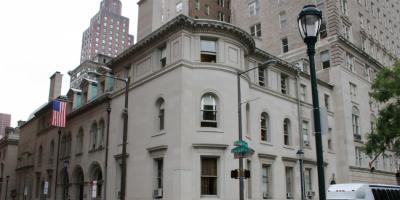In the first quarter of the nineteenth century, classicism was replaced by a new direction in art and architecture - the Empire style. Its characteristic attributes began to appear in architecture - monumental massiveness with exquisite decorative elements. The Empire style arose during the reign of Napoleon. Although some consider this direction in art and architecture to be narrow and limited, it nevertheless relied on the artistic heritage of Greek archaism and imperial Rome, drawing from there the power and grandeur of pretentious but beautiful elements, while its predecessor - classicism - was oriented mainly on soft and harmonious elements.
Origin of the style
Empire style in architecture consists of massive porticoes with columns, numerous military symbols - laurel wreaths, armor, eagles, etc. All these elements did not influence feelings, but rather the civic position of people. This is precisely what was manifested in the solemnity and splendor of the palace interiors created by Fontaine and Percier.

Afterwards, undivided planes of walls and pylons and stylized sphinxes began to be introduced into the Empire style in architecture. A characteristic feature of this time was that Egyptian traditions were combined quite organically with Roman ones, without turning into eclecticism until a certain time. Historicism is another characteristic feature that distinguishes the Empire style in architecture, which emphasized the connection with the greatness of the ancient emperors.
Ideology of style
The rigid ideological orientation limited the development of the style and became the reason that many states did not accept it, since “imperialism” began to be forcibly imposed by Napoleon in the course of his conquests. For example, in Germany and Austria at that time the “Biedermeier” movement developed, partly using Empire motifs, but opposing itself to it. In England, the "George IV style" arose, sometimes called "English Imperial".

Imperial style in Russia
The only country in which the Empire style in architecture, and not only in it, developed, was Russia. This was explained by the fact that she managed to break the power of Napoleon, and therefore here he found his own character traits. It was softer and more flexible. The founder of the Empire style in the architecture of St. Petersburg was C. Rossi, a Russian-Italian architect who managed to smooth out its coldness and rigidity. Another in this direction is V. Stasov. According to experts, the “Moscow Empire style” in the style of village estates, which is also called metropolitan classicism, had a special originality.

The end of the era of classicism
Art became a source of creative inspiration for architects Ancient Greece during the archaic period and Ancient Rome the late period of the empire in combination with the culture of Etruria, Ancient Egypt and other civilizations. Plastic ideas of ancient Egyptian architecture, undivided large surfaces of walls with massive columns and pylons, providing clarity with geometric correctness of solid volumes, etc. - all this distinguished the Empire style. became the personification of laconicism, monumentality and strict balance and symmetry of parts. This time is called the period of establishment of military glory and imperial greatness, realized through numerous symbols and signs.
In the decorative decoration of the interiors and exteriors of buildings, in furniture, as well as in lamps and utensils, a huge number of symbols of military glory and emblems were used, borrowed from ancient Roman decorative means in the form of trophies and laurel wreaths, announcer bundles and eagles, torches and the often repeated letter N .

Such exotic decor only enhanced the theatricality of the interior. Examples of Empire style in architecture, according to experts, very clearly characterize the direct borrowing of certain types and forms from the object world of antiquity. For example, triumphal arches and memorial obelisks were built and decorated accordingly.
Instead of sophistication and subtlety
With the advent of the Empire era, art became larger-scale and monumental. At the same time, the exquisite subtlety in the style of Louis XVI is replaced by excessive rationality with pomp and even pathos. In the desire of the bourgeoisie, which had won and abandoned the “royal” direction, to imitate the life or customs of the ancient Romans, there was much that was theatrical or ostentatious. In some European countries, the aristocracy and the big bourgeoisie, for whom French classicism from the time of Louis XVI had recently been a role model, began to openly follow the imperial style.

After the revolution in Paris, again from different places numerous artists and architects gathered who chose to work in this new style. The Empire style in whose buildings did not resemble a more “collected” classicism, unlike previous trends, had a rather cosmopolitan character, which, due to its regulation, excluded the creation of local schools. However, this did not prevent the birth of a Russian version of this style after some time.
Saint Petersburg
This direction was in 1810-1830. began to manifest itself in the largest urban planning ensembles. Examples of the Empire style in the architecture of St. Petersburg are the famous Kazan Cathedral and the Spaso-Preobrazhensky and Trinity Cathedrals, Ostrovsky and Arts Square. Such outstanding architects as K.I. Rossi and A.N. Voronikhin, J.B. Thomas de Thomon and V.P. Stasov and others worked on them.

Externally, the Russian Empire style in architecture, examples of buildings of which are literally scattered throughout the northern capital, is striking primarily by the use of classical order systems, and not only Tuscan or Doric. Following the era of Alexander's classicism, a desire for chic, pomp and monumentality appears, combined with masculinity. Empire style in architecture, photos of buildings of which testify to strict symmetry and solemnity, along with the laconicism of its forms, is also replete with militaristic symbolism.
The final “chord” of the Russian Empire style
Empire style architecture, examples of which can be seen most in Russia in St. Petersburg, clearly expresses the mood of that time. The apotheosis of this Russian trend is St. Isaac's Cathedral. It was built in 1858 according to the design of O. Montferrand. It is dominated by the most simple shapes: a cube with a square, a triangle, a cylinder and a parabolic dome, which, in addition to its large size, gave the temple some additional monumentality and created the impression of imperial centuries-old inviolability. During the construction of the cathedral, progressive technical solutions of that time were used: a solid slab grillage made of cast iron ribs on the domes, columns made of solid granite monoliths. The rich exterior decor with colorful interiors is also striking.

Decline of the "Golden Age"
Thus, the era of the Empire style in the architecture of St. Petersburg, framed by the construction of two of the most grandiose monuments - the buildings of the Kazan and St. Isaac's Cathedrals, completed that stage in the development of the city when many unique works of architecture were created. However, if the “golden age” in Russian literature, painting and music was just beginning, in Russian architecture it was nearing its end.
- (from the French empire empire), a style in architecture and art of the first three decades of the 19th century, completing the evolution of classicism. Focusing on examples of ancient art, the Empire style primarily relied on the artistic heritage of archaic... Art encyclopedia
empire style- a, m. empire m. 1. A large monarchical state of ancient and modern times. BISH. In French it is pronounced: empire. What is an empire? , one friend asked me. This is the unification of those who cannot be united under one power, I answered. Ogarev Empire. 2... Historical Dictionary Gallicisms of the Russian language
empire style- EMPIRE, ah, m. What l. pompous, pretentious, pompous, pretentious. Not an empire woman. Stalin's Empire style architecture from the times of J.V. Stalin. Soviet Empire style typical Soviet architecture... Dictionary of Russian argot
- (from French empire lit. empire), style in architecture and decorative arts of the first three decades of the 19th century, which completed the development of classicism. Massive lapidary, emphatically monumental forms and rich decor (military emblems, ornaments),... ... Big Encyclopedic Dictionary
Empire style- Empire. F.O. Jacob. Locker. National Museum. Fontainebleau (France). EMPIRE (from the French empire, literally empire), a style in architecture and decorative art of the 1st third of the 19th century, which completed the development of classicism. Originally formed in... Illustrated Encyclopedic Dictionary
AMPIRE, Empire style, male. (French empire, lit. empire) (law). Artistic style, prem. in architecture and furniture, spreading from France during the imperial era (at the beginning of the 19th century) to the West. Europe and Russia. Russian Empire style. Dictionary Ushakova. D.N.... ... Ushakov's Explanatory Dictionary
- (from the French empire, literally empire), a style in architecture and decorative art of the 1st third of the 19th century, which completed the development of classicism. Originally formed in France under Napoleon I, it served to embody the ideas of state power.… … Modern encyclopedia
1. a, husband Originated in France at the end of the 18th century. 19th century a style in architecture and decorative arts based on imitation of ancient models. 2. unchangeable Having this style, made in this style. Architecture a. | adj. empire, oh, oh (to... Ozhegov's Explanatory Dictionary
- (from the French empire, literally empire), a style in the architecture of the first quarter of the 19th century, which completed the evolution of classicism. Focusing on examples of ancient art, he relied on the artistic heritage of archaic Greece, the imperial... ... St. Petersburg (encyclopedia)
Noun, number of synonyms: 1 style (95) Dictionary of synonyms ASIS. V.N. Trishin. 2013… Synonym dictionary
- (French empire - lit. empire) - a style in architecture and decorative art of the first three decades of the 19th century, which completed the development of classicism. It took shape during the period of the empire of Napoleon I in France, where it was distinguished by the ceremonial splendor of the memorial... ... Encyclopedia of Cultural Studies
Books
- Empire style "B", Victor Pelevin. The young man becomes a vampire, a superman, one of the representatives of a race that bred people to feed them like cattle. In his new life he will have to study the most important sciences to understand...
- Empire style "B", Victor Pelevin. The young man becomes a vampire, a superman, one of the representatives of a race that bred people to feed like cattle. In his new life he will have to study the most important sciences to understand...
The Empire style in Moscow, which was used in the construction of buildings of national importance, had the features of architectural examples of antiquity. The architects used monumental massive porticoes, a combination of geometric shapes with military paraphernalia.

Empire style buildings in Moscow

The old University building is the embodiment of the Empire style in Moscow. Initially, the structure was erected by the architect Kazakov according to. The Moscow Empire style is characterized by coldness and severity at the same time as luxury and pomp. The University building was restored by the architect Gilardi, who kept it in the same style.

The semicircular hall of the University is distinguished by its beautiful Empire style painting and the presence of an elegant white colonnade supporting a balcony.

The first architect who erected architectural monuments in the Empire style in Moscow was Beauvais. His the best building Gagarin's mansion is considered to be from that majestic period.

A famous work of architectural art in Moscow of this period is also the Naydenov Estate, built by architects Gilardi and Grigoriev. The building is a house with an elegant Ionic portico and a monumental staircase leading from the garden to the second floor.

On the territory of the estate there are also pavilions and gazebos, also designed in the Empire style. The halls of the main building of the estate are decorated with Empire paintings.

Provision warehouses- outstanding architectural monuments in Moscow in the Empire style.
The last example of the Empire style was the university church, erected under the leadership of the architect Tyurin.
Empire style in Moscow: Triumphal Gate and the Temple of St. Louis

The triumphal gates in Moscow in the Empire style were erected on Tverskaya Zastava Square in honor of the victory of the Russian people in Patriotic War 1812. One of the best architects of that time, Beauvais, worked on the project.

A copy of this Empire gate was erected according to Libson's design on Kutuzovsky Prospekt. This monument is the first and only arched structure in Moscow, made in the Empire tradition.

The Church of St. Louis in Moscow is the result of the work of the architect Alessandro Gilardi and is a striking example of the Empire style. The temple building is a reflection of Greek and Roman mythology, philosophical ideas and the artistic language of that time. The architect took as a basis the image of an ancient Greek temple - a round or rectangular building surrounded by columns.

Despite all the pompousness of the architectural structures of that time, including temples, they were distinguished by their simplicity and laconic forms. Symmetry and rigor of decorative decoration are mandatory criteria that an empire-style temple must meet.
Empire style(from the French empire - “empire”) - the style of high classicism in architecture and applied art. It originated in France during the reign of Emperor Napoleon and developed during the first three decades of the 19th century.
The search for elegant simplicity of forms and decoration is gradually replaced by the desire for their utmost monumental expressiveness. The Empire style is characterized by greater staticity, pomp, brilliance and pomp. The decorative style solution prevails over the constructive one. Like classicism, the Empire style is focused on examples of ancient art, but interspersed with the artistic heritage of archaic Greece and imperial Rome. The decoration uses motifs to embody majestic power and military glory (monumental forms of massive porticoes, military symbols, laurel wreaths, eagles and military armor in architectural details). In addition, the Empire style included individual ancient Egyptian architectural and plastic motifs (large undivided planes of walls and pylons, massive geometric volumes, Egyptian ornament, stylized sphinxes, etc.).
The distinctive features of this style are luxury, the use of valuable natural materials, the abundance in the interior of columns, bas-reliefs, cornices and other architectural details reminiscent of ancient temples and palaces. Imitation of the style of antiquity can also be seen in heavy draperies, gold and bronze inlays of furniture and decorative items. The Empire style also showed itself in furniture decoration: the legs and armrests of chairs are made in the form of lion paws, huge canopy beds predominate, etc. The Empire style suited the time, mood and taste of the Russian nobility so much that it quickly left the palaces and spread throughout Russia.
The new urban planning and artistic ideas put forward by a number of architects of the era of the Great French Revolution became the basis for the development of the Empire style, receiving interpretation in various countries, dictated by the local characteristics of social and political life. During the reign of Napoleon, the purpose of glorifying the successes of the state was served by memorial architecture (triumphal arches, memorial columns), sometimes repeating ancient Roman designs (for example, the arch on Place Carrousel in Paris is a repetition of the Arch of Septimius Severus in Rome). The Empire style received distinctive national features in Great Britain, Denmark, and Italy. And in Russia and Germany, he became an exponent of the ideas of state independence, which the people of these countries defended in the anti-Napoleonic wars.
The new style expressed patriotic feelings and glorified the state power of Russia. The construction of large public buildings came to the fore. The interaction of architecture with monumental sculpture, which revealed and concretized the ideological and figurative content of buildings, reached a culminating level. There has been an increased desire for solemn pomp and emphasized monumentality architectural solutions. The heyday of the Empire style in art is perhaps the most brilliant era of Russian culture. The majesty of forms and nobility of proportions of the imperial style seem to attract one to itself. Therefore, the Empire style is reflected in architecture and sculpture, furniture and lamps, porcelain and painting, fashion and fabric, glass, steel and stone.
Examples of architectural structures of the Empire era in St. Petersburg are:
1. St. Isaac's Cathedral (O. Montferrand)
2. Ensembles of Palace Square with the General Staff building (K. I. Rossi)
3. New Admiralty building (A. D. Zakharov)
4. Alexandria Column(O. Montferrand)
5. Moscow triumphal gate (V. P. Stasov)
6. Mining Institute (A. N. Voronikhin)
7. Mikhailovsky Palace (K. Rossi)
Brief description of the architectural style:
1. Character traits: classicism is characterized by restrained decor and expensive quality materials (natural wood, stone, silk, etc.). The most common are stucco decorations and sculptures.
2. Predominant colors: green, pink, purple with gold accent, blue.
3. Lines: strict repeating vertical and horizontal lines; bas-relief in a round medallion; smooth generalized drawing; symmetry.
4. Form: expressive pompous monumental forms.
5. Interior elements: military decor (emblems); symbols of power.
6. Constructions: massive, stable, monumental, rectangular, arched.
7. Window: rectangular, elongated upward, with a modest design.
8. Doors: rectangular, paneled; with a massive gable portal on round and ribbed columns; with lions, sphinxes and statues.
Empire style (French style Empire - “imperial style”) - the style of late (high) classicism in architecture and applied arts. It originated in France during the reign of Emperor Napoleon I and developed during the first three decades of the 19th century.

Empire style is the final stage classicism , arose in the first third of the 19th century. In France during the era of Napoleon Bonaparte, there was a degeneration of classicism into an official imperial style imposed from above, the essence of which was reflected in its name (from the French empire - “empire”). The style became widespread in many European countries and actively developed during the first three decades of the 19th century. In imperial France, the Empire style was distinguished by the solemnity and pomp of memorial architecture and palace interiors created by Napoleon's court architects Charles Percier and Pierre Fontaine.



In the Russian Empire, this style appeared under Alexander I. Inviting foreign architects to Russia was a frequent occurrence, since it was fashionable among titled persons, and at the beginning of the 19th century there was a passion for French culture in Russia. For construction St. Isaac's Cathedral Alexander I invited an aspiring French architect Henri Louis Auguste Ricard de Montferrand, who later became one of the founders of the “Russian Empire style”.

The Russian Empire style was divided into Moscow and St. Petersburg, and such a division was determined not so much by territorial characteristics as by the degree of separation from classicism - the Moscow one was closer to it. Most well-known representative Petersburg style of the Empire style became an architect Carl Rossi, among other representatives of this style it is customary to name architects Andreyan Zakharov, Andrey Voronikhin, Osip Bove, Domenico Gilardi, Vasily Stasov, sculptors Ivan Martos, Feodosius Shchedrin.
Examples of the St. Petersburg Empire style:


Examples of the Moscow Empire style:


Empire style refers to the so-called “royal styles”, which can be characterized by theatricality in the design of architectural buildings and interior interiors. The peculiarity of the architectural Empire style lies in the obligatory presence of columns, pilasters, stucco cornices and other classical elements, as well as motifs that reproduce almost unchanged ancient examples of sculpture, such as griffins, sphinxes, lion paws and similar sculptural structures. These elements are arranged in an orderly manner in the Empire style, maintaining balance and symmetry. The artistic concept of the style with its massive lapidary and monumental forms, as well as rich decoration, the content of elements of military symbolism, the direct influence of artistic forms primarily of the Roman Empire, as well as Ancient Greece and Hellenism, was designed to emphasize and embody the ideas of the power of government and the state, the presence of a strong army.



In Russia, the Empire style dominated architecture until 1830-1840. The revival of the Empire style in degenerate forms occurred in Russia during the Soviet era, from the mid-1930s to the mid-1950s. This Empire style is also known as "Stalin Empire style" .










